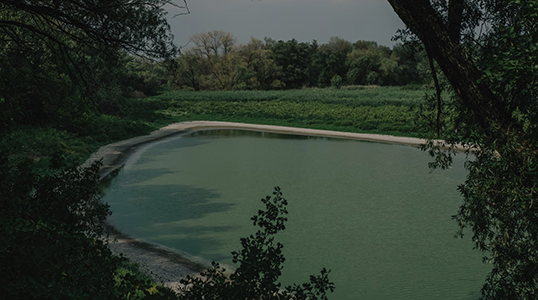A year later, animals, birds and saplings are populating a new landscape of ponds and lagoons
||| FROM THE GUARDIAN |||
Standing in a scene of shimmering green, Vadym Maniuk pointed to a young white willow tree. “What happened here is a miracle,” he said. “Some of the saplings are already 4 metres tall. There is nowhere else like this on the planet. Not even the Amazon comes close.”
Maniuk, an ecologist, picked his way through a jungle of new branches. The sky above was scarcely visible. In the mud – cracked after days of sweltering temperatures – were the remains of molluscs. The scientist showed off black poplars, also racing upwards, reeds and a small mulberry. Under the leaves it was pleasantly cool.
Just over a year ago, the spot where Maniuk stood was under several metres of water. In the 1920s Stalin ordered the construction of a series of hydroelectric power stations along the Dnipro. The area between two of the dams – one in Zaporizhzhia, the other in Kakhovka – became a vast artificial lake.
This Soviet reservoir swallowed up ancient Cossack sites as well as vegetable gardens and grazing pastures used by generations of Ukrainian villagers as a source of food and fuel. The Kremlin promised modernity instead: electricity and irrigation for fields and collective farms across the southern region.
In 2022, with the USSR long gone, Vladimir Putin launched a full-scale invasion of independent Ukraine. The reservoir quickly became part of the frontline. Russian troops sat on the left bank, Ukrainian forces on the right. Then, in June 2023, Moscow blew up the Khakovka power plant downstream as Kyiv began a big counterattack.
The explosion released more than 14 cubic kilometres of water, flooded settlements and killed at least 35 people. Last month Ukraine’s president, Volodymyr Zelenskiy, described the destruction as a “deliberate and calculated crime”. In the immediate aftermath, the reservoir resembled an alien landscape, barren and desertlike.
Within a couple of months, however, the first green shoots appeared. “I visited in August last year. It was already bright green. I was in shock, in a good way,” Maniuk said. “Before, there was a lot of water. People didn’t use it much. Now it’s enthralling and full of life.”
This week, Maniuk visited Malokaterynivka, a village once popular with fishers, on the railway line to Crimea. Its station closed when all-out war began. The Russians were about 10 miles away and smoke billowed in the distance. On the banks of the ex-reservoir are boulders and a white nacreous shore made up of dead molluscs, millions of them.
Beyond that, the forest begins. According to Maniuk, the canopy covers about 140,000 hectares, and looks similar to the primordial forest of 100,000 years ago at the end of the last ice age. Russian soldiers have not entered it. “You can’t see anything. Anyone going inside would get lost. There are bogs and rivers,” he said.
In the absence of humans, animals and birds have taken up residence. A cuckoo and swallows flew above the treeline. A local shopkeeper, Karina, said she saw wild boar from her second-floor balcony. “Scientists say rebuilding the reservoir after Ukraine wins will cause a second ecocide. I’m more worried the boar will eat our vegetables,” she said.
**If you are reading theOrcasonian for free, thank your fellow islanders. If you would like to support theOrcasonian CLICK HERE to set your modestly-priced, voluntary subscription. Otherwise, no worries; we’re happy to share with you.**








